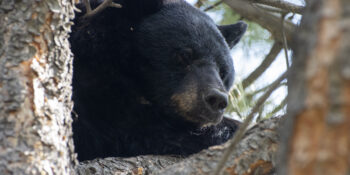A black bear sitting in a tree on Sept. 29, 2021 in a Littleton neighborhood just north of the S. Platte Canyon Rd. exit off of C-470 (photo courtesy of Jason Clay/CPW)
DENVER – Colorado Parks and Wildlife received 3,701 reports of sightings and conflicts with bears in 2021, which was a 28 percent decrease from the average number of reports over the previous two years in the Centennial State.
Bear activity varied across the state in 2021, mainly attributed to weather and drought patterns in Colorado for most of the spring, summer and into fall. Over 90 percent of a bear’s natural diet is grasses, berries, fruits, nuts and plants – native crops all dependant on moisture.
“One of the biggest things that determines what level of bear activity we are going to see as far as human-bear conflicts is whether we get good monsoonal summer moisture,” said Adrian Archuleta, Area Wildlife Manager for CPW out of Durango. “That is really critical in order to make the berries and acorns pop. In years where we get good moisture and the food mast is readily available and abundant, we don’t tend to have as much interactions and conflict. In years where it is very dry or we have a freeze event, a late frost, it can be very detrimental.”
Listen to the Colorado Outdoors Podcast episode with Archuleta talking about bears in Colorado
On the eastern side of the Continental Divide, where moisture was plentiful over the majority of winter, spring and early summer, CPW’s northeast and southeast regions saw a large decrease in the number of bear reports. The southeast saw a decline of 39.8 percent in bear calls from the average of the two previous years (2019 and 2020) while the northeast region of Colorado saw a 38.2 percent decrease.
The southwest region also had a big reduction in bear reports in 2021 compared to the average of the two previous years (51.2 percent decrease), but the northwest, where much of the region was in severe drought, was up. The 1,834 bear reports filed from the northwest in 2021 was 192 more than in 2020, but was also fewer than the 2,146 on record for 2019.

Courtesy the U.S. Drought Monitor
In 2019, CPW launched a new tracking system to help wildlife managers track and quantify bear activity and conflicts across the state. The data derived from this system is utilized to see the overall picture, trends and identify sources of conflict on a localized, regional and statewide level. Since its implementation on April 1, 2019, CPW has recorded 14,013 reports of sightings and conflicts with bears, of which nearly ⅓ are traced back to bears getting into trash.
[WATCH] Progression map showing reported bear activity across Colorado in 2021
The data from the annual bear cycle is helpful in identifying the sources of conflict, because that varies across the state.
Bears trying to access trash is the leading cause of conflict. Other constant sources of conflict include birdfeeders, livestock, bears accessing open garages and other human originated items that are left unsecured. These could all easily be reduced if the public takes some simple steps around their homes and properties to prevent bears from accessing them.
“We need help from local communities to develop strategies to secure garbage and other attractants across bear habitat,” said Kristin Cannon, Deputy Regional Manager for CPW’s Northeast region. “Ultimately, it will also require individuals to take some responsibility and follow proper guidelines on living appropriately with bears to protect them.”
One concern CPW is aware of from the public is a reluctance to report bear activity over of a belief that it will lead to the bear being put down.
Data shows that of the 14,013 reports wildlife managers have received on bears in the last three years, only 2.3 percent of those led to euthanization.
When CPW is made aware, especially when conflicts first begin, wildlife officers can educate the community, make site visits to homes to help them secure attractants and can haze bears in an attempt to reinforce their natural fear of humans. In specific circumstances, wildlife officers can attempt relocating bears out of conflict areas to alleviate safety concerns or before that animal’s behavior escalates to a dangerous level that may require euthanization. In the last three years, CPW has relocated 213 bears from sites of conflict, but wildlife officers stress that relocation is not a fix-all solution.
The data below is on the number of bears euthanized and relocated annually by CPW. The euthanization numbers released in prior years have been updated from what has been previously reported, as internal auditing each spring quantifies all sources of bear mortality in Colorado. These figures are based on these reports reviewed by CPW’s terrestrial section as of April 1 annually, so the 2021 figures could alter from what is reported here after the section has the opportunity to confirm the data.
2021: 66 euthanized, 51 relocated
2020: 158 euthanized, 118 relocated
2019: 101 euthanized, 44 relocated
2018: 79 euthanized, 24 relocated
2017: 190 euthanized, 109 relocated
2016: 66 euthanized, 16 relocated
2015: 115 euthanized, 40 relocated
Wildlife managers estimate that Colorado has between 17,000-20,000 bears and that the population is stable and growing. Black bear is the only species of bear in the state, however these bruins can be brown, blond, cinnamon and black in color.
To learn more about bears and what you can do to reduce conflicts, please visit us online by clicking here.
Photos below:
Left: Map of bear activity in Colorado in 2021
Right: A bear up a tree in Castle Rock on Sept. 16, 2021 (courtesy of Jason Clay/CPW)



Leave a Reply